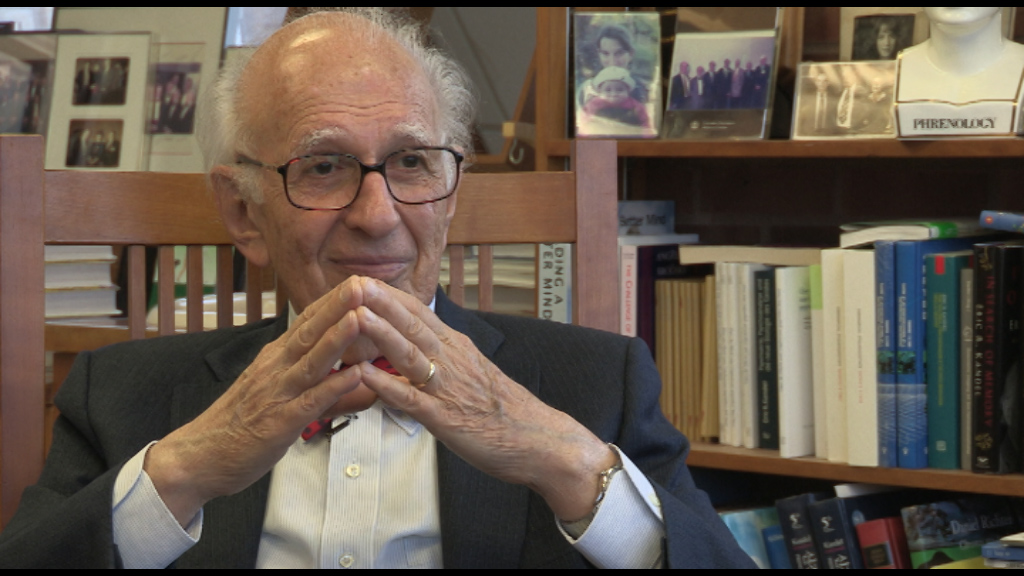NEXT STORY

CPEB and exploring age-related memory loss
RELATED STORIES

NEXT STORY

CPEB and exploring age-related memory loss
RELATED STORIES



We began to look at the stability of the place cell map as a function of attention. Now here we were unbelievably lucky. See all the early work had been done on rats. Rats don't run around. So for anyone to develop a place cell map you had to throw pellets into the enclosure and draw the animals' attention, so they implicitly drew the animals' attention whenever they did an experiment.
Mice run around all the time. You don't have to do a darn thing to get them to move around. And we found when you just let them run around like this, the place cell map forms, but it's unstable. After 12 hours, 24 hours—disappears. If you increase the attention by throwing in pellets, there's even… a little bit of stability, lasts a little bit longer. If you draw more attention, if you move them back and forth from one enclosure to another, even more stable. But if you force them to learn something about space, it's unbelievably stable. And what we did was, mice hate sound and music. It's unlike adolescent Americans. Turn on the lights and you play jazz music, they hate it. The only way they could shut it off was to find a particular position within that space, sit on it for 10 seconds, and that would shut off the sound of the music. At first they hit it randomly, and then they learned where it was, and boom, they mastered it. The map was unbelievably stable. And then we could show, we could simulate that stability, at least in good parts with D1, D5 receptor agonists. And even now we're still working on the problem.
Kimberly Kempadoo in my lab has marked the dopamine releasing cells with channelrhodopsin. She's going to be able to stimulate individual cells and see the release of this. Now in the course of this she's made a marvellous discovery. People have always wondered, you know, there is clearly a dopamine effect in the dorsal hippocampus where the place cells are, but there are very few nerve cells, very few processes that come from the actual dopaminergic cells in the striatum. So she looked at that, and she found this is true. That if you stimulate those cells, the dopamine cells, you don't get much of a stabilization of place cell behavior, of spatial behavior. But it also was known that the locus coeruleus cells, the noradrenergic cells, released dopamine. In fact, Arvid Carlsson with whom I was later to share the Nobel Prize, described dopamine, which had been missed by earlier students of synaptic transmission, because it's a precursor step to synthesizing norepinephrine. But it turns out that not only is it a precursor, it's also released. She [Kimberly] showed it was released, she did back-tracing experiments, she showed she filled up the locus coeruleus cells. And when you stimulate them, you in fact get release of dopamine. So we have not yet done the experiment of stimulating them and stabilizing the place cells. But that's where we're building up to do, I'm just showing you that this is building up to this.
Eric Kandel (b. 1929) is an American neuropsychiatrist. He was a recipient of the 2000 Nobel Prize in Physiology or Medicine for his research on the physiological basis of memory storage in neurons. He shared the prize with Arvid Carlsson and Paul Greengard. Kandel, who had studied psychoanalysis, wanted to understand how memory works. His mentor, Harry Grundfest, said, 'If you want to understand the brain you're going to have to take a reductionist approach, one cell at a time.' Kandel then studied the neural system of the sea slug Aplysia californica, which has large nerve cells amenable to experimental manipulation and is a member of the simplest group of animals known to be capable of learning. Kandel is a professor of biochemistry and biophysics at the College of Physicians and Surgeons at Columbia University. He is also Senior Investigator in the Howard Hughes Medical Institute. He was the founding director of the Center for Neurobiology and Behavior, which is now the Department of Neuroscience at Columbia University. Kandel's popularized account chronicling his life and research, 'In Search of Memory: The Emergence of a New Science of Mind', was awarded the 2006 Los Angeles Times Book Award for Science and Technology.
Title: Investigating the stability of the place cell map as a function of attention
Listeners: Christopher Sykes
Christopher Sykes is an independent documentary producer who has made a number of films about science and scientists for BBC TV, Channel Four, and PBS.
Tags: Kimberly Kempadoo
Duration: 3 minutes, 33 seconds
Date story recorded: June 2015
Date story went live: 04 May 2016